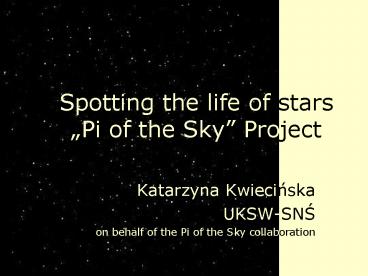Spotting the life of stars - PowerPoint PPT Presentation
Title:
Spotting the life of stars
Description:
on behalf of the Pi of the Sky collaboration 'Pi of the Sky' goal is ... Photometric data flown home every~ 3 months. An astronomical pipeline ... – PowerPoint PPT presentation
Number of Views:33
Avg rating:3.0/5.0
Title: Spotting the life of stars
1
Spotting the life of starsPi of the Sky Project
- Katarzyna Kwiecinska
- UKSW-SNS
- on behalf of the Pi of the Sky collaboration
2
Pi of the Sky goal is
- to investigate objects of the variability
timescale from seconds to years. Especially - to look for optical counterparts of GRB
afterglows - GRB are short (0.01-100s) impulses
- They are emitted by extragalactic sources
- They can originate from supernovae explosions
(collapse to a black hole), neutron stars
collisions, etc - Nowadays satellites record 2-3 GRB per month and
send alerts via GRB Coordinate Network
3
Pi of the Sky
- Taking so many exposures we can observe many
other astronomical phenomena like - Variable stars
- Meteors, etc.
4
Pi of the Sky apparatus
5
Data flow
6
Data flow
- 2 cams x 3000 exposures x 8 MB50 GB/night
- First and Second Level Triggers implemented
- 20 000 stars per image (30 000 on co added
images) - 120 000 000 photometric measurements/night
- Raw data accessible for 5 days
- After reduction 2 GB/night
- Photometric data flown home every 3 months
7
An astronomical pipeline
- Obtaining a light curve of a star requires
several steps of analysis on each frame.
8
Reduction. Its goal is to reduce an apparatus
effects. In general it consists of two steps
- A dark frame subtraction. It allows to reduce
effect of a dark current accumulating in CCD
pixels. The dark frame is obtained by exposing a
chip with a closed shutter.
- A flat-field frame division. It permits to
correct a lens optics. In general the flat-field
frame is obtained by exposing the chip to a
source of homogeneous light for example by
taking sky pictures at dusk. Unfortunately, it is
not a good method for large FOV because of a
brightness gradient. So our flat-field is
obtained from a median of frames taken at the
same night with a fixed mount.
9
Photometry
- It creates a list of stars occurring on the
frame at coordinates (x,y) and calculates their
instrumental brightness. The instrumental
brightness is simply a sum of pixel values in a
certain pre-defined neighborhood of a star,
called aperture, minus the background level.
10
Astrometry
- It compares the list of stars in instrumental
coordinates (x,y) witha star catalogue and finds
transformations of instrumental coordinates into
the physical coordinates on the sky. Then it
calculates the celestial coordinates of each
star on the frame.
11
Cataloguing
- It calibrates the instrumental brightness by
comparing results for certain number of reference
stars, and determines the physical brightness, or
magnitudo, of each star on the frame.
12
Visualization - Data Base
13
Sigma vs. magnitudo
14
Effective FOV
15
Effective FOV
- ?
16
Effective FOV
- 33 x 33 CCD
- 29 x 29 taking into account the mount drift
and the mask - 28 x 28 if we want to compare two nights
17
Light curves
18
Conclusions
- Because of the mount drift and the shift between
succeeding nights, effective FOV is about 5 deg
smaller from each side of a frame. - Imperfect cataloguing procedure makes that mean
magnitudo depends significantly on time. It is of
importance especially when we talk about
long-period stars. - If we want to distinguish a physical variability
from the imperfect cataloguing effect, it is
necessary to make the photometry much more
stable.
19
- The end.

